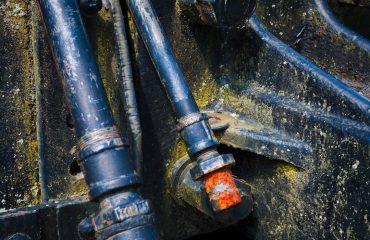Radiographic inspection (RT) is a crucial non-destructive testing (NDT) method used to detect internal flaws and imperfections in pipes. This powerful technique employs penetrating radiation, either X-rays or gamma rays, to create images revealing hidden defects that could compromise the integrity of the pipeline. This comprehensive guide will delve into the intricacies of radiographic pipe inspection, exploring its applications, techniques, advantages, limitations, and safety considerations.
Understanding the Principles of Radiographic Pipe Inspection
Radiographic inspection relies on the principle of differential absorption of radiation. When X-rays or gamma rays pass through a material, their intensity is reduced depending on the material’s density and thickness. Denser areas, like metallic pipe walls, absorb more radiation, while areas with flaws, such as cracks, voids, or corrosion, absorb less. This difference in absorption creates variations in the intensity of the radiation reaching a detector (typically a film or digital image receptor), resulting in a radiographic image. Denser areas appear lighter, while less dense areas appear darker, making flaws readily identifiable.
The choice between X-rays and gamma rays depends on factors such as the pipe’s thickness and material. X-rays are generally preferred for thinner pipes and require specialized equipment. Gamma rays, emitted by radioactive isotopes, are better suited for thicker pipes and offer greater portability, though they pose higher safety concerns.
Types of Radiographic Techniques Used in Pipe Inspection
Several radiographic techniques are employed for pipe inspection, each tailored to specific situations and pipe configurations. These include:
- Single-wall exposure: This technique is used for inspecting a single wall of the pipe at a time. It’s straightforward but requires multiple exposures for complete inspection of multi-walled pipes.
- Double-wall exposure: This technique allows for simultaneous inspection of both pipe walls in a single exposure. It is efficient but requires careful setup to avoid overlapping images and ensure proper interpretation.
- Panoramic radiography: This method is particularly useful for inspecting long lengths of pipe. It involves using a specialized technique to capture a wide area in a single exposure, reducing the number of individual shots.
- Computed Radiography (CR) and Digital Radiography (DR): These digital techniques replace traditional film-based radiography, offering advantages like immediate image viewing, enhanced image quality, and reduced processing time. They also enable image manipulation and analysis, enhancing defect detection.
Applications of Radiographic Inspection in Various Pipe Industries
Radiographic inspection finds widespread application across numerous industries that rely on pipelines for transporting fluids or gases. These include:
- Oil and Gas Industry: RT is vital for ensuring the integrity of pipelines transporting crude oil, natural gas, and refined petroleum products. It helps detect corrosion, erosion, cracks, and other defects that could lead to leaks or explosions.
- Chemical Processing Industry: Pipelines in chemical plants handle corrosive substances, making regular inspection crucial. RT helps identify internal corrosion and stress corrosion cracking, preventing catastrophic failures.
- Power Generation Industry: Pipelines in power plants carry steam, water, and other fluids under high pressure and temperature. RT plays a critical role in detecting flaws that could compromise safety and operational efficiency.
- Water and Wastewater Treatment: RT can be used to inspect pipes in water and wastewater treatment facilities, identifying corrosion, erosion, and other defects that can affect water quality and infrastructure integrity.
Advantages and Limitations of Radiographic Pipe Inspection
Radiographic inspection offers several advantages:
- High sensitivity: RT can detect even small flaws that are difficult to identify using other NDT methods.
- Permanent record: Radiographic images provide a permanent record of the inspection, which can be reviewed and analyzed later.
- Comprehensive inspection: RT can inspect a large area of the pipe relatively quickly.
- Versatile: It can be adapted to various pipe materials, sizes, and configurations.
However, it also has some limitations:
- Safety concerns: RT involves ionizing radiation, requiring strict adherence to safety protocols and trained personnel.
- Accessibility limitations: Inspecting pipes in difficult-to-reach locations can be challenging.
- Cost: RT can be relatively expensive compared to other NDT methods.
- Interpretation requires expertise: Accurate interpretation of radiographic images requires skilled and certified personnel.
Safety Precautions in Radiographic Pipe Inspection
Safety is paramount during radiographic inspection. Strict adherence to safety regulations and procedures is crucial to minimize radiation exposure to personnel. Key safety measures include:
- Radiation shielding: Use of appropriate shielding materials (lead, concrete) to protect personnel from radiation exposure.
- Distance: Maintaining a safe distance from the radiation source during exposure.
- Time: Minimizing the time spent in the radiation field.
- Personnel monitoring: Using dosimeters to monitor individual radiation exposure levels.
- Proper training and certification: Ensuring that personnel involved in RT are properly trained and certified to handle radioactive materials and interpret radiographic images.
- Emergency procedures: Establishing clear emergency procedures in case of accidents or malfunctions.
Radiographic inspection is a powerful tool for ensuring the integrity of pipelines across diverse industries. By understanding its principles, techniques, advantages, limitations, and safety protocols, engineers and technicians can effectively utilize this NDT method to prevent costly failures and maintain safe and reliable pipeline operations.




